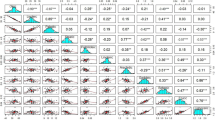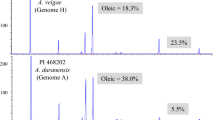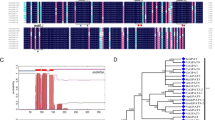Abstract
A panel of 55 peanut lines was analyzed for fatty acid composition with gas chromatography and also genotyped with SNP markers from the FAD2 genes by real-time PCR. Significant variation in fatty acid composition was identified, and the ratio of oleic acid to linoleic acid (O/L) ranged from 1.23 to 56.45. In terms of the FAD2 gene mutation, the assayed lines were classified into four genotypes: wild type (Ol1Ol1Ol2Ol2), single functional homozygous mutation on the A genome (ol1ol1Ol2Ol2), single functional homozygous mutation on the B genome (Ol1Ol1ol2ol2), and a double mutation on both A and B genomes (ol1ol1ol2ol2). Each genotype has a significantly different fatty acid profile. Both FAD2A and FAD2B are involved in the conversion of oleic acid to linoleic acid in peanuts. Overall, these results demonstrate the combined power of genetic analysis with biochemical analysis on peanut fatty acid research.


Similar content being viewed by others
References
Ahmed EM, Young CT (1982) Composition, quality, and flavor of peanuts. In: Pattee HE, Young CT (eds) Peanut science and technology. American Peanut Research and Education Society, Yoakum, pp 655–688
Barkley NA, Chenault-Chamberlin KD, Wang ML, Pittman RN (2010) Development of a real-time PCR genotyping assay to identify high oleic acid peanuts (Arachis hypogaea L.). Mol Breed 25:541–548
Barkley NA, Wang ML, Pittman RN (2011) A real-time PCR genotyping assay to detect FAD2A SNPs in peanuts (Arachis hypogaea L.). Electron J Biotechnol. doi:10.2225/vol14-issue1-fulltext-12
Brown LD (1979) A proof that the Tukey-Kramer multiple comparison procedure for differences between treatment means is level for 3, 4, or 5 treatments. Technical Report, Dept Mathematics, Cornell Univ
Chen Z, Wang ML, Barkley NA, Pittman RN (2010) A simple allele-specific PCR assay for detection FAD2 alleles in both the A and B genome of cultivated peanut for high oleate trait selection. Plant Mol Rep 28:542–548
Chu Y, Ramos L, Holbrook CC, Ozias-Akins P (2007) Frequency of a loss-of-function mutation in oleo-PC desaturase (ahFAD2A) in the mini-core of the U.S. peanut germplasm collection. Crop Sci 47:2372–2378
Chu Y, Ramos L, Holbrook CC, Ozias-Akins P (2009) Two alleles of ahFAD2B control the high oleic acid trait in cultivated peanut. Crop Sci 49:2029–2036
Gorbet DW, Knauft DA (2000) Registration of ‘SunOleic 97R’ peanut. Crop Sci 40:1190–1191
Isleib TG, Wilson RF, Novitzky WP (2006) Partial dominance, pleiotropism, and epistasis in the inheritance of the high-oleic trait in peanut. Crop Sci 46:1331–1335
Jung S, Powell G, Moore K, Abbott A (2000a) The high oleate trait in the cultivated peanut [Arachis hypogaea L.]. II. Molecular basis and genetics of the trait. Mol Gen Genet 263:806–811
Jung S, Swift D, Sengoku E, Patel M, Teule F, Powell G, Moore K, Abbot A (2000b) The high oleate trait in the cultivated peanut [Arachis hypogaea L.]. I. Isolation and characterization of two genes encoding microsomal oleoyl-PC desaturases. Mol Gen Genet 263:796–805
Knauft DA, Ozias-Akins P (1995) Recent methodologies for germplasm enhancement and reeding. In: Pattee HE, Stalker HT (eds) Advances in peanut science. American Peanut Research and Education Society, Stillwater, OK, pp 54–94
López Y, Nadaf HL, Smith OD, Connell JP, Reddy AS, Fritz AK (2000) Isolation and characterization of the Δ12-fatty acid desaturase in peanut (Arachis hypogaea L.) and search for polymorphisms for the high oleate trait in Spanish market-type lines. Theor Appl Genet 101:1131–1138
Norden AJ, Borget DW, Knauft DA, Young CT (1987) Variability in oil quality among peanut genotypes in the Florida breeding program. Peanut Sci 4:7–11
Vassiliou EK, Gonzalez A, Garcia C, Tadro JH, Chakraborty G, Toney JH (2009) Oleic acid and peanut oil high in oleic acid reverse the inhibitory effect of insulin production of the inflammatory cytokine TNF-α both in vitro and in vivo system. Lipid Health Dis 8:25
Wang ML, Chen CY, Davis J, Guo B, Stalker HT, Pittman RN (2009) Assessment of oil content and fatty acid composition variability in different peanut subspecies and botanical varieties. Plant Genet Resour 8:71–73
Acknowledgments
The authors gratefully thank Mr. Brandon Tonnis for his excellent assistance on fatty acid analysis, Mr. Jerry Davis for his help on statistical analysis, Drs. Gary Pederson, Paul Raymer, and anonymous reviewers for their useful comments and suggestions on improving the quality of this manuscript.
Author information
Authors and Affiliations
Corresponding author
Rights and permissions
About this article
Cite this article
Wang, M.L., Barkley, N.A., Chen, Z. et al. FAD2 Gene Mutations Significantly Alter Fatty Acid Profiles in Cultivated Peanuts (Arachis hypogaea). Biochem Genet 49, 748–759 (2011). https://doi.org/10.1007/s10528-011-9447-3
Received:
Accepted:
Published:
Issue Date:
DOI: https://doi.org/10.1007/s10528-011-9447-3




